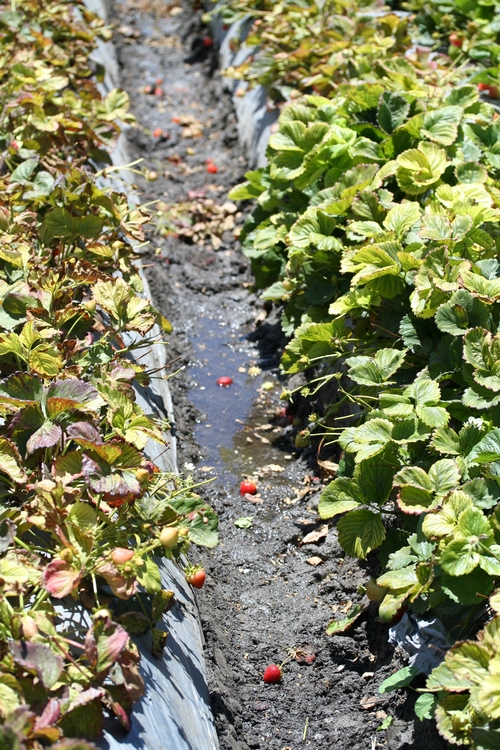
Testing a Field of Yellow Strawberry Plants in Salinas for Sodium Toxicity
The following is a test of the thesis proposed last year concerning the emergence of yellowed strawberry plants in many fields around Salinas and Castroville. To review, in the field tested last year, areas of yellow plants were found to be associated with high levels of calcium carbonate (lime), meaning that calcium tied up with carbonates was not available to limit the amount of exchangeable sodium, subsequently leaving this sodium to poison the strawberry plants and turn them yellow.
The test was done in a field in the Salinas area demonstrating classic symptoms. This particular field has several very large areas of yellowed plants, interspersed with areas of green plants which are apparently doing quite well.
I took four bulk tissue samples from each area of green plants and then another four bulk tissue samples from each area of yellow plants. Since we found last year that the very top of the bed is the area which shows the most dramatic differences in sodium concentration, a total of three bulk soil samples were taken from these levels in corresponding areas of green and yellow plants.
Refer to the tables below for the results of the tissue and soil tests.
Table One. Tissue Mineral Concentrations
|
Mineral |
Yellow Plants |
Green Plants |
|
Total Nitrogen (%) |
2.40 |
2.09* |
|
Total Phosphorous (%) |
0.74 |
0.65 |
|
Total Potassium (%) |
0.98 |
0.75 |
|
Total Sulfur (ppm) |
0.18 |
0.14 |
|
Total Boron (ppm) |
96.09 |
74.36 |
|
Total Calcium (%) |
1.00 |
1.31 |
|
Total Magnesium (%) |
0.39 |
0.42 |
|
Total Zinc (ppm) |
22.20 |
19.08 |
|
Total Manganese (ppm) |
141.82 |
169.60 |
|
Total Iron (ppm) |
230.31 |
256.02 |
|
Total Copper (ppm) |
7.78 |
6.54 |
|
Total Molybdenum (ppm) |
1.31 |
0.99 |
|
Total Sodium |
595.40 |
148.43* |
|
Total Chloride |
2683.92* |
3737.57 |
* Probability that the two sets are the same is less than or equal to 5% (p <0.05) using a Student's paired t-Test of two-tailed distribution.
Table Two. Soil Mineral and Chemical Characteristics
|
Mineral |
Yellow Plants |
Green Plants |
|
Nitrate (NO3-N) - ppm |
17.3 |
8.9 |
|
Ammonia (NH3-N) - ppm |
3.4* |
6.0 |
|
Phosphorous - ppm |
41.9 |
44.6 |
|
Potassium – ppm |
216.9 |
234.1 |
|
Calcium – ppm |
4989.6 |
3935.0 |
|
Magnesium – ppm |
1503.0 |
1138.5 |
|
Sodium – ppm |
386.2 |
335.6 |
|
Chloride – ppm |
15.2 |
17.3 |
|
SAR |
2.8 |
2.6 |
|
Zinc -ppm |
1.4 |
1.6 |
|
Iron - ppm |
9.6 |
10.5 |
|
Manganese - ppm |
3.4 |
2.4 |
|
Boron |
1.1 |
1.1 |
|
Soil pH |
7.8 |
7.6* |
|
Percent carbonates as CaCO3 |
1.41 |
0.92* |
* Probability that the two sets are the same is less than or equal to 5% (p <0.05) using a Student's paired t-Test of two-tailed distribution.
It is very easy to ascertain that this field situation is very similar to the field in Castroville evaluated last year. Sodium in the tissues of the yellowed plants is extremely high with an average of 595 ppm, compared against an average of 148 ppm in the green. Chloride curiously is lower in the yellow than in the green, but both averages are not exceedingly high.
Looking at the soil, we again find that the percent carbonates as calcium carbonate are significantly lower around the green plants than the yellow and the pH is also consequently lower around these green plants.
This indicates that calcium is being tied up around the yellow plants and not limiting the amount of exchangeable sodium. These high levels of sodium are being in turn absorbed by the plants causing them to turn yellow and in some cases even die.

A bed of yellow strawberries next to one more or less green.

Green strawberry plant surrounded by yellow plants.
